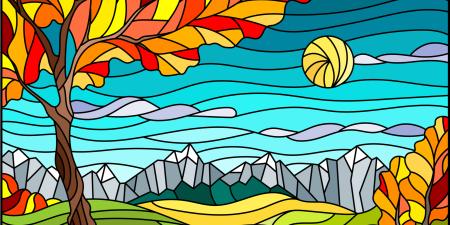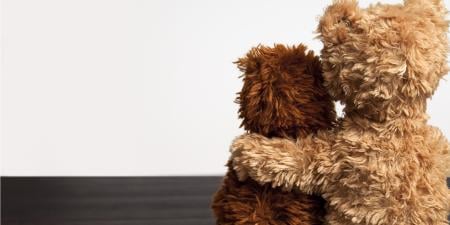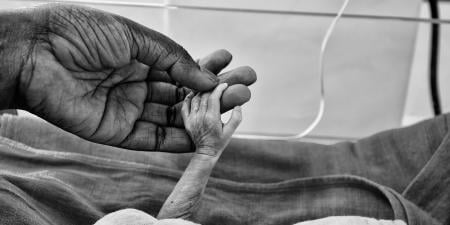Embracing Life Before and After the Death of a Child by Kathy Lesher
Follow the stream, have faith in its course. It will go its own way, meandering here, trickling there. It will find the grooves, the cracks, the crevices. Just follow it. Never let it out of your sight. It will take you.
Sheng-yen
These words remind me to slow down and have faith that I will be shown the way. As the social worker for Noah’s Children, a pediatric palliative care and hospice program in Richmond, Virginia, I am often asked the question, “How do you do it?” I can’t really explain how I do what I do. I have been working with Noah’s Children for the last 4-1/2 years, yet it feels like I have been doing this work for much longer. It’s not like I learned how to do it in school or from a textbook. I think it’s just in my being—as if it was gifted to me somehow. I love the work I do and, as long as I am able to follow the stream, I will continue to give to and receive from amazingly courageous patients and families who face challenges most people cannot conceive of. I walk with them on an arduous journey and am there with them while their child is living and after their child dies.
Another question I am asked is, “Isn’t it depressing working with children who will die?” While there are times when I feel sad and times when I am overwhelmed by what I carry, I also experience a great deal of beauty and joy and learn so much from the families I work with. I can walk into a family’s home and have my spirits lifted when, along with the sadness and pain, I witness hope, love, and the sense of living completely in the moment because they don’t know how much time they have with their child. I meet with parents who initially struggled to come to grips with the fact that their child was born with a life-limiting condition and not expected to live beyond infancy. Now, 3 years later, their child is very much alive, and, while they are aware of the reality of the situation, they are thriving. Or I encounter parents who are incredible advocates for their children and others with special needs and their families. Or perhaps I attend a funeral or memorial service that truly honors and celebrates the life of the child. Knowing that I am able to help a family face the end of a life, while finding hope and embracing the preciousness of life, is far from depressing.
I would like to share a story about a family from Tanzania and give you a glimpse of the journey we have taken together. The language and cultural differences have been a challenge, but along with a compassionate interpreter, our interdisciplinary team has provided support to this family in numerous ways. Their beautiful baby was born with trisomy 18, a chromosome disorder, and the prognosis was poor. The parents were uncertain about bringing their baby home from the hospital and were considering having her placed in a facility; they were not sure they could handle the baby’s special medical needs. Several weeks after we talked with them about our services, the parents decided to bring their baby home, and we admitted them into our program. We found out later that the parents feared they would be in legal trouble if their baby died at home. We helped them understand that the family could be together at home when their baby died and it would not be necessary to call the police. We supported them as they made the very difficult decision to sign a DDNR. We were there when their baby died, just a few weeks before she would have turned 3 months old.
Sad? Yes. Painful? Indeed. The mother was on the floor, weeping, moaning. The father kept leaving the room where their daughter’s body lay. The baby’s 3-year-old sister had fallen asleep, and her 5-year-old brother was running around the apartment in his usual manner, periodically stopping to look at his sister’s body. The baby’s two oldest sisters cried and drew pictures. They so wanted to hold their sister, but their mother would not allow it because of something that had happened when they lived in Africa: a young woman had held the body of a deceased relative and then was never able to have children. As a grief counselor, I knew that holding the baby would help the girls in their healing process, but I had to let go of that notion; I had to follow the stream.
When the parents were ready, I notified the funeral home. The priest arrived, along with family and friends; prayers were said, songs were sung; and then the mother carried her precious baby out of the apartment, leading the procession down the stairs to the funeral home’s van. She laid her tiny little baby on the stretcher. I will never forget the image of the father as he stood by his baby and ever so gently fixed the blanket that covered her so it was just right. Time stood still. He seemed mesmerized as he smoothed the wrinkles in the blanket, tears rolling down his face. Amidst the anguish there was beauty and sacredness and I was honored to be present, to witness, and to quietly support.
A week or so later I received a call from the father. In his limited English, he asked me to pick up the baby’s leftover formula to give to other families. When I arrived, I was greeted by the father, the mother, and their 3- and 5-year-old children. There had been concern for the mother because she had a history of postpartum depression, which can be exacerbated by the death of a child. I had always sensed a deep sadness in her and I rarely saw her smile. As we were gathering the many boxes of formula, I found a piece of bubble wrap, the kind with the big bubbles. I showed the 3-year-old how to pop the bubbles. She couldn’t do it with her fingers, so I stomped on the bubbles with my foot. She was so little, she couldn’t pop them that way either. My next approach was to jump on the bubbles. This she could do. By this time, her 5-year-old brother was intrigued and came into the room to see what we were doing. The three of us held hands and, moving in a circle on the little piece of bubble wrap, we jumped and jumped and jumped, making a lot of noise and laughing. At one point I looked over at the mother, and she was laughing along with us. Our eyes met, and for the first time I saw a flicker of joy, of hope. The fact that we do not share the same culture or language did not matter at that moment; we connected in a way we had not before.
I have been wondering about the best approach to providing bereavement services to this family, in particular the mother. When I spoke with the interpreter later, she reported, with a smile, that the mother had told her about the bubble wrap. The mother told the interpreter that I was very nice. Somehow, this affirmed my idea to print the photos a volunteer photographer had taken of the family, bring the mother a scrap book and other supplies, and offer her an opportunity to move towards healing through creative expression. We won’t need to talk; we can just sit together, remembering her beautiful baby and the preciousness of life. I will follow the stream and its flow…walking on sacred ground.
Ella’s Story from Christi and David Hancock
During a routine ultrasound and screening when I was 12 weeks pregnant, we were devastated to find out our baby had trisomy 13. We had never heard of this chromosome disorder, and, as our perinatologist explained its physical ramifications, our hearts broke. It was a sad and scary diagnosis; most babies do not make it to birth. If they do, the life span is very short: minutes to weeks. If you are among the lucky few, your baby might live a year, rarely more. At the time we found the results of the test, we also found out our baby was a girl. It broke our hearts to know our baby girl’s body would fail her. As we went through detailed ultrasounds, our perinatologist found the features associated with trisomy 13—a cleft palate and lip and possible kidney, heart, and brain abnormalities. Because few babies with trisomy 13 survive, there is limited information about them, and a precise prognosis could not be given. We prayed and hoped we would meet our baby girl, Ella.
We were blessed that Ella remained strong in utero until 35 weeks gestation, when I went into labor. Her heart rate dropped during labor, but she was a fighter. When we heard her first breath, we were elated that we could hold her and love her and she would know us, even if just for a few moments. She was such an amazing gift. As her minutes turned into hours and then a day, the doctors and nurses in labor and delivery were impressed by her strength. Fortunately, during Ella’s first day of life, our pediatrician recommended that a pediatric palliative care team, Noah’s Children, come visit us in the hospital. When they came into our room that day, our lives as a thriving family seemed possible. Our pediatrician wanted us to take Ella home after that visit. The idea of taking her home to be with her big brother and sister and us, with the guidance of palliative care, brought us an indescribable feeling of comfort and hopefulness. It was a turning point; we no longer felt helpless with our precious baby. We did not know how long she would be with us on Earth, but we wanted her life to be as special and comfortable as it could possibly be. Since that first visit from Noah’s Children, through Ella’s life and death and into the present, we have had the gift of pediatric palliative caregivers to walk with us.
We were so fortunate to bring Ella home the day after she was born. The next day, we had a nurse and a social worker come from Noah’s Children and we immediately felt a sense of peace and trust. We felt encouraged by their experience, knowledge, help, and compassion. They held Ella while the nurse, Cathy, examined her. They explained that they were on call for us 24 hours a day for both medical and emotional needs, which was an unbelievable relief. As things became more difficult for Ella, we called Cathy in the middle of the night with some questions. She answered them and encouraged us, but also came to our home to be with us. This was a huge convenience and comfort because Ella often developed breathing problems brought about by being in certain positions.
Two days after we brought her home, Dr. Bob Archuleta, the founder and medical director of Noah’s Children, came into our home. In his kind and gentle manner, he educated us on trisomy 13, giving us some possible expectations for Ella’s health, comfort, and typical causes of death for children with her disorder. We appreciated his honesty. He also taught us about comfort care and what options were available as problems with Ella’s health arose. He guided us with information and compassion. We were always an intimate part of the process and had the final say in decisions regarding her care. Like the rest of his staff, Dr. Archuleta was always patient and made us feel like we were the only family in the program. We were also blessed that Ella’s primary pediatrician completely supported the approach we were taking in her care, and he complemented the efforts of Noah’s Children. The beginning of our pediatric palliative care relationship, with God’s hand, allowed us to let go and live life to the fullest with Ella. We were able to appreciate and enjoy the time we had with her.
Noah’s Children’s interdisciplinary team meets needs in addition to the medical. Our compassionate and knowledgeable social worker, Kathy, has served as our counselor during Ella’s life and after her death. She openly and consistently reached out to us and to our now 4-year-old twins, whose lives have certainly been affected by their sweet baby sister. She counseled us on how to cope with feeling at once so blessed by the amazing gift of Ella and so fearful and filled with sadness. She counseled us on how to talk about Ella dying, especially to our twins. She gave us books to read to them, suggested art therapy (two of their drawings are below), and most importantly encouraged honest communication.
Kathy has also been an enormous resource in other ways. She arranged for a brilliant professional photographer to come to our home to take pictures of our family at no charge when Ella was 2 weeks old. These pictures completely capture Ella and our family life with her and are an irreplaceable reminder of our cherished memories. Kathy also gently encouraged us to prepare thoughts for a memorial service in an attempt to alleviate some of the distress when Ella passed away. She was completely supportive of how much we did or did not want to do, and we are grateful we had ideas ahead of time. She explained what we should do when Ella died in our home, which made that time as smooth as could possibly be expected. She also did an exceptional job filling a spiritual role as well. Another amazing gift from Noah’s Children is the support they continue to provide, 2 years after Ella’s death. Kathy has continued to counsel our family, which has contributed monumentally to our strength.
To have a physician, nurse, and social worker in our home who actually knew about trisomy 13 and understood the day-to-day life of babies with the disorder was a matchless gift. They felt, and continue to feel, like family. They have been here just the right amount: as little or as much as we wanted. We believe Ella was the most special gift, and they clearly did as well. They have taken a genuine interest in all of our children. Their emotions paralleled ours, whether it was happiness or sadness, and they were complimentary of our care for Ella, which means so much, considering the limited time we had with her.
We feel blessed that God chose us as Ella’s family. We cherish the time we had with her. We could not have remained so positive if Noah’s Children was not here to uplift and help us. It was so painful waiting for our child to die, but they allowed us to stay centered and focused on spending time as a family. Because of palliative support, compassion, and knowledge, we were able to just be with Ella and to truly live life with our sweet baby girl. Because of Noah’s Children, we were free to develop memories—pink skies, butterflies, and the warm sun on our faces—that keep her close to us.
First drawing, by Sierra: Ella in heaven giving flowers to God next to a rainbow, with the sun and clouds in the sky and a big yellow and green flower. Ella has wings and a halo and is wearing slippers!
Second drawing, by Dawson: Ella in heaven with a big, hot sun, 2 (red) clouds above her, with grass, a black flower, and a red tree below her. Ella has wings and a halo and toes!
Rae’s Story from Amy Spangler
As parents we must make many decisions regarding our children—homecare or daycare, public school or private school. Rarely do we think about long-term medical care for our children, until a life-altering illness or accident occurs. For the past 11 years I have had to make medical choices for my son, Rae, and 3 years ago every one of them decided his fate.
Rae was diagnosed with aplastic anemia at age 6, had a stem-cell transplant and right-leg amputation at 10, and was diagnosed with dyskeratosis congenita at 14. On April 17, 2007, we were told he had 3 to 6 months to live. I’ll never forget his looking at me on the way home. He said, “They just told me I’m going to die.” “Yes,” I said, “but we are going to live life to the fullest and take it day by day.” It has now been 3 years since his diagnosis.
We entered into Noah’s Children, a pediatric palliative care group, in May 2007. We were introduced to our team: Dr. Archuleta; Cathy, the nurse; and Kathy, the social worker. Unfortunately, there are no magical ways to fill your child’s last days. As parents, you want to protect them from dangers and harm, especially when you know they will be leaving before you’re ready. As parents and patient, you have a lot of questions and want a lot of answers, answers that won’t be given. You come to rely on these team members for comfort, reason, and understanding, especially when you have other children. In our 3 years with Noah’s, our team has become part of our family. They don’t tell us how things should be done; instead, they help us reach our own decisions, and then they support us.
My goal was, and continues to be, for Rae to live life. We have always respected his choices and given him as much control as possible over his medical care. We know our time with him is limited and that there are things we could do to prolong his life with us, but that would be unfair to him. I have always believed that life is about quality—not quantity. We have allowed him to be as active as his body can tolerate. Last summer, he was determined to ride the roller coasters at Busch Gardens. It was all he talked about. We discouraged him, told him that he might not make it off alive. Our team talked with him, but he wasn’t going to be deterred. His response was, “At least I’ll die doing something I enjoy.” So the team and I sat down and discussed all the possibilities and how things would be handled if, in fact, he did not survive the ride. Thankfully, we went, he rode, and he is still here.
In the past year, a lot has changed for us. Rae has started to struggle mentally and physically and has many questions that none of us can answer. Our daily lives revolve around Rae and how he feels. His heart and lungs are shutting down, and the lack of oxygen means he has a hard time processing simple tasks. As parents, we are filled with mixed emotions and sometimes feel guilty for our thoughts. Our team keeps us in check. For the most part, the feelings we experience are normal for what is happening in our lives.
I can’t imagine where our family would be without our team. They have helped us overcome many obstacles in this journey. They have seen us at our best and worst. They have listened to our frustrations, watched many tears shed, but have always been there with caring, positive words and hugs.



